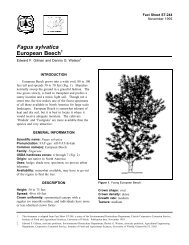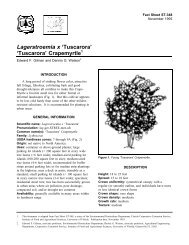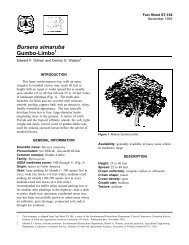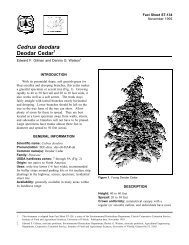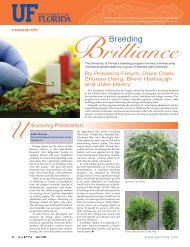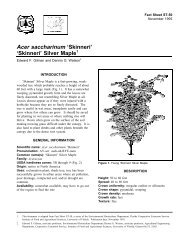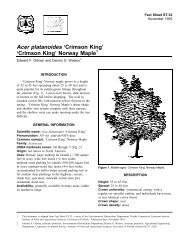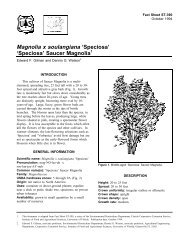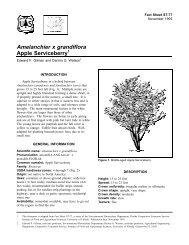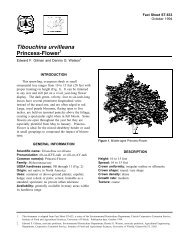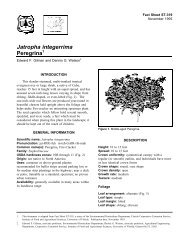Fagus sylvatica 'Atropunicea' - Environmental Horticulture ...
Fagus sylvatica 'Atropunicea' - Environmental Horticulture ...
Fagus sylvatica 'Atropunicea' - Environmental Horticulture ...
You also want an ePaper? Increase the reach of your titles
YUMPU automatically turns print PDFs into web optimized ePapers that Google loves.
<strong>Fagus</strong> <strong>sylvatica</strong> ‘Atropunicea’<br />
Purple European Beech 1<br />
Edward F. Gilman and Dennis G. Watson 2<br />
INTRODUCTION<br />
Purple European Beech grows into a wide oval, 70<br />
to 80 feet tall and spreads 50 to 70 feet (Fig. 1).<br />
Leaves emerge deep purple and fade somewhat to a<br />
purple-green during the summer. Branches normally<br />
sweep the ground in a graceful fashion. The tree<br />
grows slowly, recovers slowly from transplanting and<br />
prefers a sunny location and a moist, light soil.<br />
Though not a street tree, the tree makes one of the<br />
finest specimens of all those available in North<br />
America for large scale landscapes. Definitely not for<br />
residential landscapes. Purple European Beech is<br />
somewhat tolerant of heat and dry soil, but it is best to<br />
locate it where it would receive adequate moisture.<br />
Purple Beech and the cultivars ‘Pendula’ and<br />
‘Fastigiata’ (‘Dawyck’) are more available than the<br />
species and very attractive.<br />
GENERAL INFORMATION<br />
Scientific name: <strong>Fagus</strong> <strong>sylvatica</strong> ‘Atropunicea’<br />
Pronunciation: FAY-gus sill-VAT-ih-kuh<br />
Common name(s): Purple European Beech<br />
Family: Fagaceae<br />
USDA hardiness zones: 4 through 7 (Fig. 2)<br />
Origin: not native to North America<br />
Uses: hedge; shade tree; specimen; no proven urban<br />
tolerance<br />
Availability: somewhat available, may have to go out<br />
of the region to find the tree<br />
Figure 1. Mature Purple European Beech.<br />
DESCRIPTION<br />
Fact Sheet ST-245<br />
November 1993<br />
Height: 50 to 75 feet<br />
Spread: 40 to 60 feet<br />
Crown uniformity: symmetrical canopy with a<br />
regular (or smooth) outline, and individuals have more<br />
or less identical crown forms<br />
Crown shape: oval<br />
Crown density: dense<br />
Growth rate: slow<br />
Texture: medium<br />
1. This document is adapted from Fact Sheet ST-245, a series of the <strong>Environmental</strong> <strong>Horticulture</strong> Department, Florida Cooperative Extension Service,<br />
Institute of Food and Agricultural Sciences, University of Florida. Publication date: November 1993.<br />
2. Edward F. Gilman, associate professor, <strong>Environmental</strong> <strong>Horticulture</strong> Department; Dennis G. Watson, associate professor, Agricultural Engineering<br />
Department, Cooperative Extension Service, Institute of Food and Agricultural Sciences, University of Florida, Gainesville FL 32611.
<strong>Fagus</strong> <strong>sylvatica</strong> ‘Atropunicea’ -- Purple European Beech Page 2<br />
Figure 2. Shaded area represents potential planting range.<br />
Foliage<br />
Leaf arrangement: alternate (Fig. 3)<br />
Leaf type: simple<br />
Leaf margin: entire; undulate<br />
Leaf shape: elliptic (oval); ovate<br />
Leaf venation: pinnate<br />
Leaf type and persistence: deciduous<br />
Leaf blade length: 2 to 4 inches<br />
Leaf color: purple or red<br />
Fall color: copper<br />
Fall characteristic: showy<br />
Flower<br />
Flower characteristics: inconspicuous and not<br />
showy; spring flowering<br />
Fruit<br />
Fruit shape: oval<br />
Fruit length: .5 to 1 inch<br />
Fruit covering: dry or hard<br />
Fruit color: brown<br />
Fruit characteristics: attracts birds; suited for human<br />
consumption; inconspicuous and not showy; no<br />
significant litter problem<br />
Trunk and Branches<br />
Trunk/bark/branches: bark is thin and easily<br />
damaged from mechanical impact; droop as the tree<br />
grows, and will require pruning for vehicular or<br />
pedestrian clearance beneath the canopy; showy trunk;<br />
should be grown with a single leader; no thorns<br />
Pruning requirement: needs little pruning to develop<br />
a strong structure<br />
Breakage: resistant<br />
Current year twig color: brown; gray<br />
Current year twig thickness: thin<br />
Culture<br />
Light requirement: tree grows in full sun<br />
Soil tolerances: clay; loam; sand; slightly alkaline;<br />
acidic; well-drained<br />
Drought tolerance: moderate<br />
Aerosol salt tolerance: low<br />
Soil salt tolerance: poor
<strong>Fagus</strong> <strong>sylvatica</strong> ‘Atropunicea’ -- Purple European Beech Page 3<br />
Figure 3. Foliage of Purple European Beech.<br />
Other<br />
Roots: surface roots can lift sidewalks or interfere<br />
with mowing<br />
Winter interest: tree has winter interest due to<br />
unusual form, nice persistent fruits, showy winter<br />
trunk, or winter flowers<br />
Outstanding tree: tree has outstanding ornamental<br />
features and could be planted more<br />
Invasive potential: little, if any, potential at this time<br />
Verticillium wilt susceptibility: not known to be<br />
susceptible<br />
Pest resistance: long-term health usually not<br />
affected by pests<br />
USE AND MANAGEMENT<br />
European Beech has given rise to many other<br />
cultivars: ‘Albo-variegata’ - leaves margined white;<br />
‘Asplenifolia’ - cut leaves; ‘Atropunica’ - leaves<br />
purple; ‘Cochleata’ - smaller, spoon-shaped leaves;<br />
‘Cuprea’ - leaves copper colored; ‘Dawycki’ - upright<br />
growth habit; ‘Fastigiata’ - upright growth habit;<br />
‘Laciniata’ - leaves cut, wider more regularly-shaped<br />
than ‘Asplenifolia’; ‘Macrophylla’ - larger leaves;<br />
‘Miltonensis’ - leader erect, main branches horizontal,<br />
side branches pendulous; ‘Pendula’ - weeping habit;<br />
‘Purpurea Pendula’ - weeping with purple leaves;<br />
‘Quercifolia’ - slow growing, leaves oak-like;<br />
‘Riversii’ - young foliage reddish then purple;<br />
‘Rohanii’ - similar to ‘Laciniata’; ‘Roseo-marginata’ -<br />
purple leaves with light pink border, grow in shade to<br />
prevent leaf burn, not easily grown; ‘Rotundifolia’ -<br />
leaves round; ‘Spaethiana’ - leaves purple; ‘Tortuosa’ -<br />
low, spreading, umbrella-like; ‘Tricolor’ - leaves green<br />
and white with pink margins; ‘Zlatia’ - leaves golden<br />
in spring.<br />
Pests<br />
Usually none are serious. Aphid colonies on the<br />
lower branches can be dislodged with a strong stream<br />
of water from the garden hose. Colonies are often<br />
disposed of by predatory insects.<br />
Borers such as flat-headed appletree borer or<br />
two-lined chestnut borer bore into trees weakened by<br />
some stress. Prevent the insect infestations by keeping<br />
trees healthy with regular fertilization and irrigation in<br />
dry weather.<br />
Regular inspections of the trunk and branches are<br />
suggested for early detection of scales. Horticultural<br />
oil sprays will help control scales.<br />
Certain caterpillars can be controlled with sprays<br />
of Bacillus thuringiensis.<br />
Diseases<br />
Usually none are serious provided soil is loose and<br />
is well-drained.
<strong>Fagus</strong> <strong>sylvatica</strong> ‘Atropunicea’ -- Purple European Beech Page 4<br />
Several fungi cause leaf spots but are generally not<br />
serious to warrant chemical control.<br />
Powdery mildew causes a white coating on the<br />
leaves. The disease is most common late in the<br />
season.<br />
Bleeding canker forms cankers from which a<br />
brownish liquid oozes. Crown symptoms include<br />
leaves of smaller size and lighter green color than<br />
normal. In severe cases the leaves wilt and the<br />
branches die. Avoid feeding with high nitrogen<br />
fertilizers as it seems to worsen the condition of<br />
infected trees.<br />
Beech bark disease occurs when the feeding site of<br />
woolly Beech scale is invaded by a fungus. The<br />
fungus kills the bark and in the process, the insects.<br />
There are no satisfactory controls for the fungus.<br />
Control the disease by controlling the scale with a<br />
horticultural oil.<br />
Cankers infect, girdle, and occasionally kill<br />
branches. Prune out the infected branches.<br />
During periods of high temperatures and low<br />
rainfall Beech leaves may scorch. Make sure trees are<br />
adequately watered.



